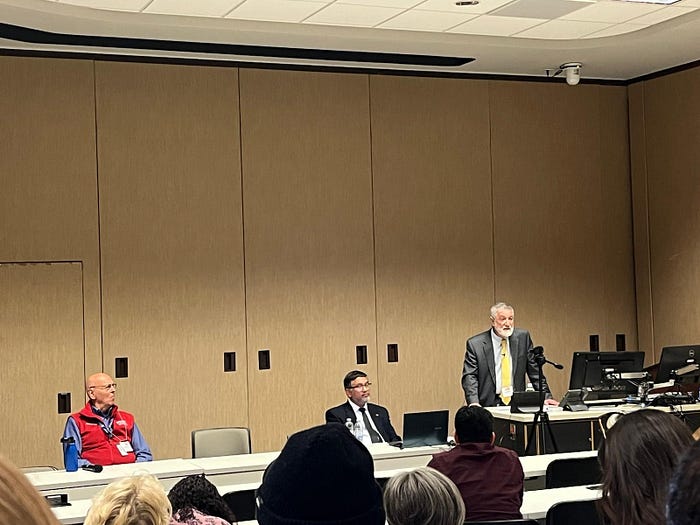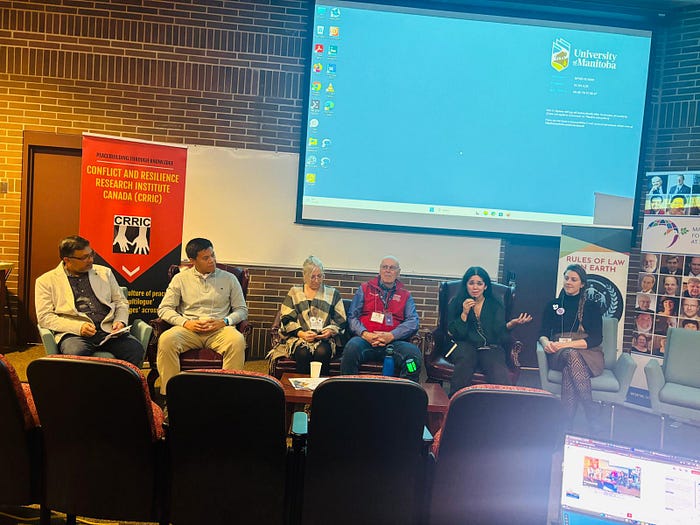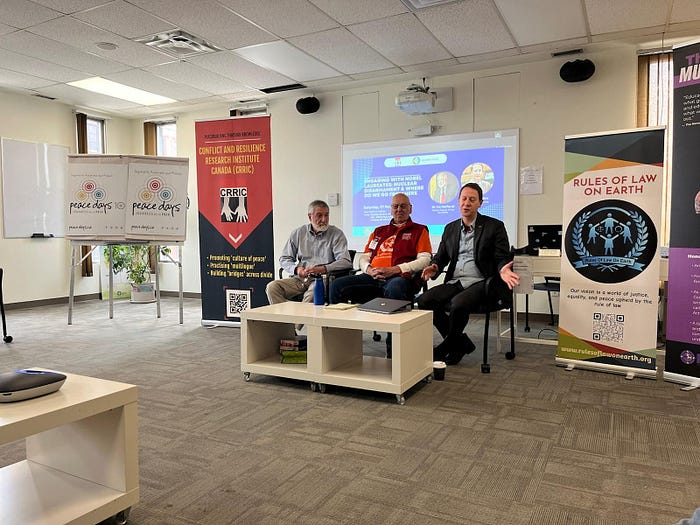From global leaders to grassroots voices, civil society unites to imagine a nuclear-free future
The world observes Disarmament Week annually from October 24 to 30 [1], along with the anniversary of the United Nations (UN). First declared by the UN General Assembly in 1978, the week aims to promote awareness and education on disarmament. In 1995, the UN further encouraged Member States and civil society to actively engage in the week to broaden public understanding of disarmament issues.
This year, Winnipeg-based activists, scholars, and civil society leaders marked Disarmament Week in a uniquely “Winnipeg style.” The 5th Youth Nuclear Peace Summit[2] was held at the Canadian Museum for Human Rights [3], the world’s only museum dedicated to human rights. In addition to the summit, several side events were organized across the city. Global leaders in nuclear disarmament attended, including two Nobel Peace Prize laureates, Dr. Ira Helfand and Seth Sheldon. This blog reflects on the side events held at the University of Manitoba and Mediation Services during the week.
Advocacy for Humanity — Faculty of Law, University of Manitoba

The first event, titled “Advocacy for Humanity: Civil Society, Nuclear Disarmament, and Environmental Protection,” took place at Robson Hall, Faculty of Law, on October 30 at noon. [4] The keynote speaker was Dr. Ira Helfand, a co-founder of two organizations that ultimately received the Nobel Peace Prize.[5] Often described as the “quietest, scariest person on the planet,” his talk underscored the urgent need for political will to achieve disarmament.
Just prior to his speech, President Donald Trump announced on Truth Social that the United States (US)would resume nuclear weapons testing after a 33-year halt.[6] Against this alarming backdrop, Dr. Helfand argued that the world has avoided nuclear war not because of wise political leadership, but largely due to luck. His message extended beyond moral, legal, and strategic arguments — reminding the audience that “we need humans for human rights.”
Dr. Helfand identified five major global nuclear flashpoints:
- U.S.–North Korea and North Korea/South Korea
- U.S.–Russia
- U.S.–China
- Middle East (Iran–Israel)
- India–Pakistan
Citing research on the catastrophic impacts of nuclear conflict, he noted that a U.S.–Russia nuclear war could kill three-quarters of the world’s population through famine, while an India–Pakistan nuclear exchange could kill one-quarter. He emphasized that Canadians are not insulated from these risks, as climate disruption, infrastructure collapse, and global food system failure would affect everyone, especially people in the western hemisphere.
Dr. Helfand urged civil society to take action by educating families, communities, and policymakers. He emphasized the importance of Canadian leadership, particularly through Canada’s potential ratification of the Treaty on the Prohibition of Nuclear Weapons — as a NATO member — an act he argued would set a powerful global precedent.
Panel Discussion on Nuclear Disarmament — St. Paul’s College

The second event[7], a panel discussion, was held the afternoon of October 30 at the Fr. Jensen SJ Theatre, St. Paul’s College. Panelists included:
- Lia Holla — Consultant, International Physicians for the Prevention of Nuclear War Canada
- Ally McDonald — National Coordinator, Canadian Voice of Women for Peace
- Linda Kalafitdas — High School Teacher, Toronto
- David G. Newman — Founder, Conflict Resilient Research Institute
- Raphael Pangalangan — Human Rights Officer, United Nations
Moderated by Dr. Kawser Ahmad, the session began with the documentary After the Big One: Nuclear War on the Prairies.[8] Panelists spoke about their personal motivations for joining the nuclear abolition movement and their current work. David shared the origins of the Youth Nuclear Peace Summit in Winnipeg, while Raphael reflected on UN efforts to assess the environmental and climate impacts of U.S. nuclear testing in the Marshall Islands.
Panelists, particularly Lia and Linda, emphasized the importance of early education on disarmament to cultivate future peacebuilders. They also highlighted Canada’s opportunity to re-establish itself as a global leader in disarmament by ratifying the Treaty on the Prohibition of Nuclear Weapons and building political will domestically.
Engaging with Nobel Laureates — Mediation Services Winnipeg

The final event, “Engaging with Nobel Laureates: Nuclear Disarmament and Where Do We Go from Here[9],” was held on November 1 at Mediation Services Winnipeg. Dr. Ira Helfand and Seth Sheldon shared their insights and engaged in a round-table conversation moderated by David G. Newman and Dr. Kawser Ahmad. Attendees included community leaders from diverse faith groups, Rotary Winnipeg members, youth peace activists, organizers of the summit, and University of Manitoba faculty and students.
Discussions centered on actionable steps communities can take to advance nuclear disarmament. Themes included building trust and social cohesion, prioritizing truth and reconciliation, collaborating across faith and community groups, and engaging respectfully with those who disagree. Participants also highlighted future platforms for advocacy, including the International Network of Museums for Peace (INMP) Conference 2026[10] at the Canadian Museum for Human Rights.
Conclusion
Winnipeg’s civic spirit shone throughout Disarmament Week. The city’s current tagline, “Winnipeg: Made from what’s real,” resonates deeply with its strong, interconnected and compassionate civil society, committed leadership, and determined movement for peace. Participating in these events and engaging with global disarmament leaders offered hope for a safer future — build on a strong civil society.
[1] United Nations, Disarmament Week 24–30 October, n.d., accessed November 2, 2025, https://www.un.org/en/observances/disarmament-week.
[2] Youth Nuclear Peace Summit, Update: YNPS 2025 Press Release, 2025, https://www.youthnuclearpeacesummit.org/.
[3] Canadian Museum for Human Rights, Canada’s New National Museum Opens, Devoted Entirely to Human Rights, September 19, 2014, https://humanrights.ca/news/canadas-new-national-museum-opens-devoted-entirely-human-rights.
[4] Organized by conflict resilience research institute in partnership with University of Manitoba Master of Human Rights Program and the Arthur V Mauro Institute of Peace and Conflict Studies, with the support of Walter C Newman Fund.
[5] Dan Drollette Jr, He Helped Found Two Groups That Won the Nobel Peace Prize: Ira Helfand of PSR, November 27, 2017, https://thebulletin.org/2017/11/he-helped-found-two-groups-that-won-the-nobel-peace-prize-ira-helfand-of-psr/.
[6] Trevor Hunnicutt et al., Trump Tells Pentagon to Resume Testing US Nuclear Weapons, Reuters, October 30, 2025, https://www.reuters.com/world/china/trump-asks-pentagon-immediately-start-testing-us-nuclear-weapons-2025-10-30/.
[7] See the event video here: https://www.youtube.com/watch?v=e9Q91kP5lOw&t=523s
[8] Link to the video: https://www.youtube.com/watch?v=qqcumimSRDE
[9] See the event video here: https://www.youtube.com/watch?v=JJ78ccRfSXg
[10] Follow the link for the call for abstracts: https://humanrights.ca/event/peacebuilding-through-truth-and-reconciliation/call-proposals

